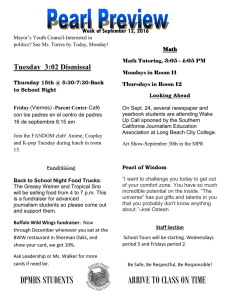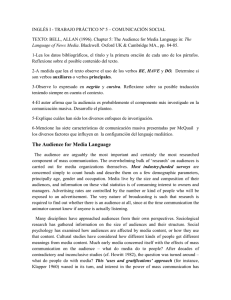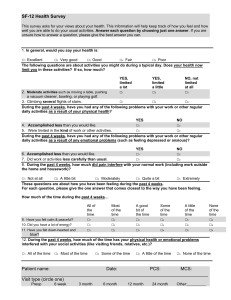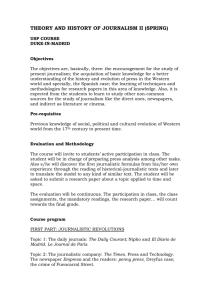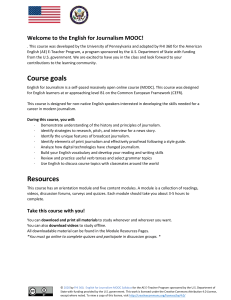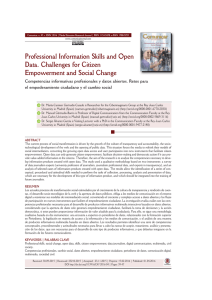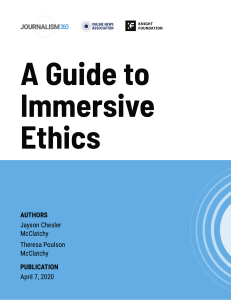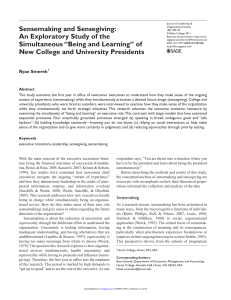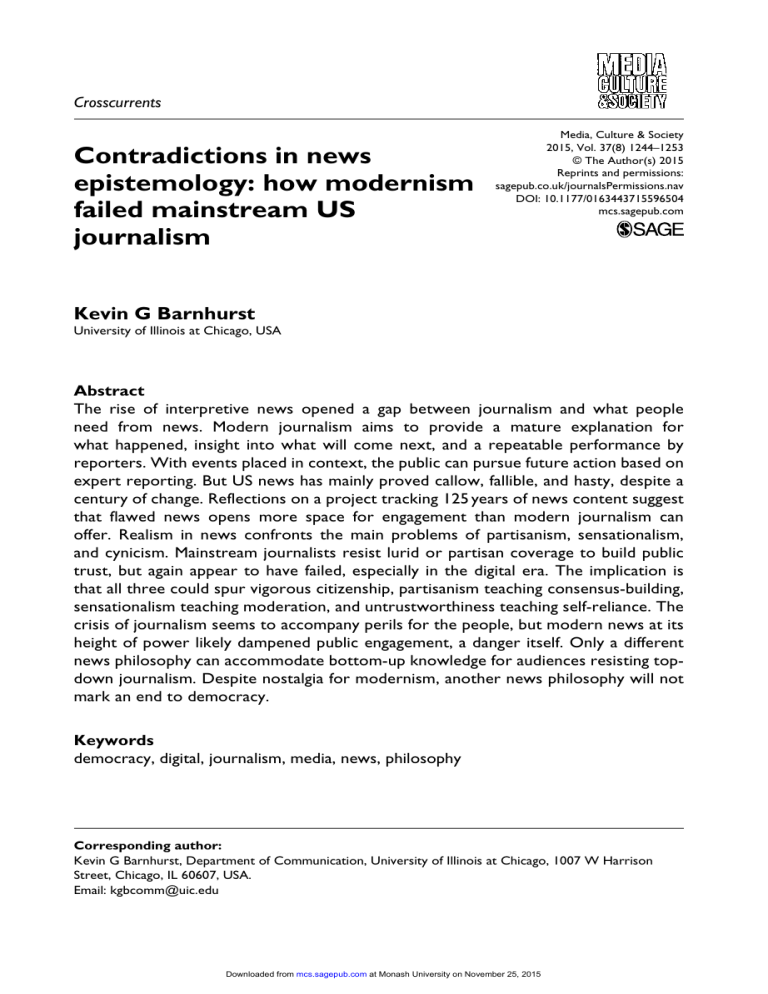
596504 research-article2015 MCS0010.1177/0163443715596504Media, Culture & SocietyBarnhurst Crosscurrents Contradictions in news epistemology: how modernism failed mainstream US journalism Media, Culture & Society 2015, Vol. 37(8) 1244­–1253 © The Author(s) 2015 Reprints and permissions: sagepub.co.uk/journalsPermissions.nav DOI: 10.1177/0163443715596504 mcs.sagepub.com Kevin G Barnhurst University of Illinois at Chicago, USA Abstract The rise of interpretive news opened a gap between journalism and what people need from news. Modern journalism aims to provide a mature explanation for what happened, insight into what will come next, and a repeatable performance by reporters. With events placed in context, the public can pursue future action based on expert reporting. But US news has mainly proved callow, fallible, and hasty, despite a century of change. Reflections on a project tracking 125 years of news content suggest that flawed news opens more space for engagement than modern journalism can offer. Realism in news confronts the main problems of partisanism, sensationalism, and cynicism. Mainstream journalists resist lurid or partisan coverage to build public trust, but again appear to have failed, especially in the digital era. The implication is that all three could spur vigorous citizenship, partisanism teaching consensus-building, sensationalism teaching moderation, and untrustworthiness teaching self-reliance. The crisis of journalism seems to accompany perils for the people, but modern news at its height of power likely dampened public engagement, a danger itself. Only a different news philosophy can accommodate bottom-up knowledge for audiences resisting topdown journalism. Despite nostalgia for modernism, another news philosophy will not mark an end to democracy. Keywords democracy, digital, journalism, media, news, philosophy Corresponding author: Kevin G Barnhurst, Department of Communication, University of Illinois at Chicago, 1007 W Harrison Street, Chicago, IL 60607, USA. Email: [email protected] Downloaded from mcs.sagepub.com at Monash University on November 25, 2015 1245 Barnhurst In spring 2009, students at the Northwestern University journalism school developed Stats Monkey, software to turn sports scores into a news story, like this one: ‘Northwestern held off a late comeback bid by Georgetown to defeat the Hoyas 5–3 Friday. Trevor Stevens led the Wildcats with two hits and one run scored …’.1 In the Northwestern magazine published that autumn, the machine-written lines introduced an article that an alum then blogged for the Hartford Courant online. NPR picked up the news in January, followed by technology bloggers. The professor-developers raised USD6 million in venture capital to found Narrative Science, and in 2011 the New York Times reported that a joint venture of the college Big Ten conference and Fox was among 20 clients signed up for the story-generating service. The publishing blog GalleyCat reported in 2012 that the client list had grown to include Forbes, which was using Narrative Science copy like, ‘Barnes & Noble (BKS) is hoping it can break the slide with solid third quarter results…’. News stories about automation focused on whether software would help or replace reporters and editors, a theme the trade press picked up after Wired magazine predicted a ‘robonews tsunami’ based on Narrative Science claims that computers would win a Pulitzer within 5 years and write ‘more than 90 percent’ of news within 15 years.2 The main role the stories implied for audiences was to guess whether a machine wrote the story (conclusion: unlikely). People would benefit from coverage of events that the established media ignore, such as Little League games, or no longer cover enough, from business earnings to school-board meetings. The developers claim the software can produce financial and political insights people need and can also entertain, ranging from breathless breaking news to snarky restaurant reviews. The understandable job fears highlight a gap between the aims for modern news and its reception among audiences. Would citizens benefit from the accurate performance that modern news pursues and that the machine apparently delivers? Probably not.3 Daily reporting of the early 20th century was an activity of the youthful, and today the labor of reporting what happens daily to local people is still a young person’s game. Washington politicians worry that citizens will miss news from government if newspapers, where the bulk of reporting still happens, continue either firing reporters or going under. The public service mission behind modern news rests on unstable ground as long as news fails to resemble other knowledge work such as law or medicine. Unlike the original professions one joins and then pursues late into life, news operates amid forces that spin off workers into adjacent roles or defection. The careers of journalists I interviewed show the pattern. Daily news reporters seem stuck in dead-end jobs or merely passing through. Reporting the day’s events tends to happen only early in the typical career, and so citizens may be getting an inexperienced account of events, which invites them to respond by adding their hard-won know-how. The modern hope for an accurate story inspires admiration but ends the conversation, exposing a contradiction of modern news. The public-at-large may benefit more from a callow rendition of events that invites completion than from perfect coverage that automated news seems to promise. A core assertion of modern professionalism is consistent performance, that any reporter following news routines will produce much the same account. Achieving that aim in the machine version may replace news laborers or free them for knowledge work, but in either case, the engaged public could suffer. Downloaded from mcs.sagepub.com at Monash University on November 25, 2015 1246 Media, Culture & Society 37(8) Would citizens benefit from reliable news that modern practice aims to achieve and that automated news might deliver? Probably not. Telling a news story involves weaving a plot built around available information and known procedures. Its actors perform roles in a band of time spanning the action, and the story reaches climax and resolution in the mediated news form, such as a newspaper (Ricoeur, 1984; White, 1973). Although modern reports decenter the practitioner, news is by definition a second-hand account. It first emerged from the convergence of keeping physical records, new printing technology, and a human desire to hear and believe something new has happened (Barnhurst and Nerone, 2001). Stories going through a mediator are hearsay in courts of law, unreliable as any retold tale. But words disseminated as news seem authoritative because of mediation (reproduction and distribution) and in spite of a close involvement of news organs with political power, which regulates but also relies on news to advance policy. Those involved tend to forget that news and politics are unsavory activities and express surprise when the audience treats both with a measure of condescension. And so a contradiction of news – that unreliable stories about current events also serve the public good – arises from the even narrower time frame of the news story. News software could produce public forgetfulness about the unreliability of second-hand accounts, leaving citizens without the task of considering the forces supplying events in ways peculiar to news. Do citizens benefit from the insights that news practitioners want to supply and the machine might generate? Probably not. My studies found modern news adopting critics’ expectations, so that reports explain events in relation to the past and future. As for the past, news practitioners have less time than social scientists – and little payoff – for looking back. News can serve up at best a quick perspective drawn from individual and collective memory in the newsroom, from the old-time ‘morgue’ of news clipping files, or from electronic search tools. Historians do a better job of assessing what happened, but because they wait a decade or more before taking on the task, they leave an opening that news fills. Working in haste, reporters then give a middling, predictable account of what went just before. Audiences, not least of all politicians and citizens, want to know what happened in the last election or other event, but no one can venture with much surety into that opening. Modern news undertakes a fool’s mission and gets it wrong often enough to expose its contradictions as a kind of knowledge. In the early years of the 21st century, US news media missed or ignored the most important stories, got them wrong, or reached them late. Examples of the bad ‘first rough draft of history’ abound.4 Business news fueled the rise of Enron, once the world’s largest energy corporation, and its fall into bankruptcy in 2001, the first huge business failure of the century. Mainstream news, especially the New York Times, fell short during the weapons of mass destruction (WMD) claims justifying the 2003 invasion of Iraq. The war led to the Halliburton contracting scandal, exposure of Central Intelligence Agency (CIA) operative Valerie Plame, torture of Abu Ghraib prisoners, and controversies surrounding the US military prison in Guantánamo Bay, Cuba. But the recent record is probably no worse than the erroneous coverage of World War I. Modern news works under an assumption about what society must do to succeed, expressed in the aphorism of George Santayana (1905): ‘Those who cannot remember the past are condemned to repeat it’ (p. 284). News practice tries to make the ‘now’ into Downloaded from mcs.sagepub.com at Monash University on November 25, 2015 1247 Barnhurst historical record, in the optimistic hope for bettering society. But any insights that machines could produce might make matters worse, not better. So-called big data give solidity to hasty conclusions. Within its short time frame, news rushes into the gap that legitimate history opens and inevitably fails. Insights published on demand about past events reaffirm the contradiction that modern news may perform a public service by supplying unsound accounts that prove wrong just often enough to keep the citizenry alert. News practitioners probably do better with the past than with trends leading into the future. Audiences, especially political elites and active citizens, want to know how the story will end, but the future is the stuff of soothsayers. By finding patterns and making assumptions about stability and change, physical science can sometimes predict what comes next. Weather reporting shows how forecasts fail as they reach further out, and the viewing public likely benefits from daily lessons on the unreliability of weather prediction. Other news occupies similar shaky ground, less like physical than social science, which cannot predict any but gross aggregate behavior as long as individuals do the sublime and ridiculous. When social scientists try to provide knowledge to direct future action, whether individual or social, they enter an ethical quagmire. The future is a matter of speculation, something scientists rule out, but when editors risk a guess about, say, impending government action, their fallible attempt opens a chance for voters to do something about it. Unerring insights would settle the matter, exposing the contradiction that the guesswork inherent in modern news may also serve the public good by keeping hopes for news content modest and expectations for citizenship ambitious. Modern news aims for accuracy, reliability, and insight, and the effort does some good while also serving to make its contradictions inescapable. They follow from the position news occupies in the lives of reporters, audiences, and society. If callow, unsound, and fallible news does more good than modernists expect, understanding the contradictions may lead to a better sense of what news can supply, how the labor of news can prosper, and which contents politicians and people need. Understanding modern news may also help close the gap between news producers and audiences, which opened through the 20th century. As news transformed, practitioners came to occupy a distinct space that set the main conditions and problems that news confronts, such as cynicism, sensationalism, and the bias of partisanism. The same -isms may not bedevil audiences. Partisanism produced trouble for journalists as soon as the emerging occupation rejected the model of the partisan press. Attacking opposition newspapers was routine in the 19th century, and partisanism, meaning partisanship or the partisan spirit, was a prominent feature in US public discussion by midcentury. The poet Rob Morris (1860) was among the first to introduce the term, remarking that ‘newspaper reading … was a pleasant compound’ that included ‘bitter partisanism’ (p. 302). Newspaper publishers like Robert R. ‘Colonel’ McCormick of the Chicago Tribune were partisans in one way, and in another, Progressives turned partisanism into a movement. When founding the St. Louis Post-Dispatch, Pulitzer set out to put people before party, criticize government administrations, and advocate ‘principles and ideas rather than prejudices and partisanship’.5 His new journalism sets the task for newspapers to distinguish justified belief from opinion. Modern news worked to segregate opinion and remove it entirely from most pages. Once US newspapers quarantined opinion, the partisan press survived only on the Downloaded from mcs.sagepub.com at Monash University on November 25, 2015 1248 Media, Culture & Society 37(8) editorial pages (Barnhurst and Nerone, 2001). The feat required editors to work more in abstraction, applying practical epistemology to root out opinion (Park, 1940). News facts align with previous events that reporters have covered, in a process parallel to the way judges consider precedent when deciding a case. Impartiality excludes feelings and ideas that incline one to judge occurrences without forethought, and news facts came to stand opposite partisanism, turning the party spirit into a kind of prejudice resulting in biased news. Reporters undertook other basic tasks of epistemology such as verification. One standard is to corroborate facts by drawing evidence from at least two news sources. In US partisan affairs, facts emerge from treating both parties with fairness by giving voice to each. The two-party model in politics extended into other news, so that reporters began looking for binaries, assuming each source has an opponent. Opinion then resides outside of news, and editors become arbiters in the balance of opinion. Under that standard, news practitioners now avoid expressing partisan views or declaring a party affiliation. Factual news is a modern adaptation to market conditions. One of the intangible values that publishers and media owners accumulate is credibility, combining believable contents, which varies, and a level of affinity that remains stable between the news organ and its audience. Credible news usually manages to present accounts that readers or viewers find plausible. After a lapse in credibility, published corrections attempt to repair the record of an event but also reassert the believability of the medium and its connection to its public. Factual news supposedly makes money when highly credible content leads to higher circulation and better ratings. The added readers and viewers generate little revenue but increase what media owners can charge for advertising, which may increase profits. But US news stories shifted back into giving opinions over the 20th century, especially on television, perhaps because markets rewarded outspoken opinion and because audience allegiance to news waned. News practitioners seem to find the citizenry imponderable, reliable only at the macro level, in the aggregate. At the micro level, individual citizens, unlike reporters, are expected to have opinions, even baseless and bigoted ones, because partisan choices lead into the voting booth. Polling emerged in the 20th century as a tamer of public opinion by finding the center, the polite consensus that pushes the rabble aside as statistical outliers. The idea of one person, one vote seems to apply to opinion surveys, which ask a narrow range of questions on topics the respondents may know little or care less about (Barnhurst and Nerone, 2001). By damping the cacophony of individual voices, polling seems to make democracy manageable for elites. News content then cites the surveys, tempering them with creditable sources to control news quality. But citizen opinion, corralled into comments and letters to the editor, is content that engages the audience, even though editors view the writers as something close to lunatics whose words require domestication. Quality-control measures to keep modern news credible and factual have failed to manage audiences. When the number of paying customers for legacy media eroded in the 21st century, some news outlets took up a partisan model, still claiming fairness and balance in the case of Fox News. Media businesses seem to treat customers at the micro level, as individuals voting for news products with their eyeballs and content purchases, expressing opinions of news by investing time and money. News outlets also compete with each other for audience attention, but competitive processes tend to make the content of different Downloaded from mcs.sagepub.com at Monash University on November 25, 2015 1249 Barnhurst outlets interchangeable, so that the news is similar but arrives in different packages. Consumers then make micro ‘purchases’ based on delivery style and presenter personality. Citizens’ awareness of an outlet’s partisan leanings may work at the macro level, applying to the whole outlet and emerging from partisan cues. The epistemology work of news, distinguishing among genres of news and positioning opinion, would be lost within the news space that audiences occupy. News producers and audiences may simplify the complex interplay of macro and micro judgments by being dismissive of each other and by agreeing a citizen should embrace partisanism where reporters and editors should not. But the opposite seems to occur, so that news practice takes control of the space of citizenship. Generating facts about what happens also defines what events mean, asserting that modern news is neutral and definitive even though the work of making meaning is political. Pushing partisan content into separate places appears to tame the bias of politics, but also hides other ways that news conveys the partisan spirit of the profession itself, just as partisan news asserted its party affiliation. A focus on credibility and quality veils the contradictions within news at the risk of deactivating the citizen. By avoiding partisanism, modern news also opens the journalist’s occupation to partisan attack, spurring politically active audiences to find other ways of staying informed. And so fighting the bias of partisanism may be fruitless. Sensationalism is another charge that has vexed news since the rise of modernism. The term sensationalism appeared in 19th-century philosophy to describe human sensation as the source of knowledge, harking back to earlier theories such as idealism.6 Chosen to avoid association ‘with what is morally vicious’ (Morell, 1846: xi), sensationalism soon came to brand novelists, dramatists, and journalists as amoral. Sensational practice peaked with yellow journalism in the 1890s. Progressive Era muckrakers and crusading writers argued that exciting human sensation could generate moral indignation and action against injustice, sustaining the press crusades boosting legislation against child labor, tainted food, and other social ills. To show children, immigrants, young women, and others beyond the view of polite society, news practice developed a kind of fieldwork in factories, brothels, and other sites of realism also found in art and literature. By the 20th century, the project to make news modern diverged from 19th-century practice by rejecting the subjective appeals underlying sensationalism and adopting routines to make coverage objective. The objective account tries to dissociate news from its realist roots by accepting occurrences as inherent in the world and regarding them without flinching either morally or emotionally. News stories could still show the underdog, but dispassionately, through expert observation committed to social change. Objective reports were versions of events that trainees could learn to produce respectably. In the tacit bargain between publishers seeking profit and workers seeking better conditions, objective news could build occupational expertise while commanding high-end markets, overshadowing the common reader that sensationalism attracted. The cheap sensational press made money from selling copies, but as advertising revenues grew around affluent consumers, news content became what marketers later came to call a ‘loss leader’. Gathering sensational stories attracted more readers but tended to lose money for publishers. Modern news aligned producers with the emerging idea of consumerism. Downloaded from mcs.sagepub.com at Monash University on November 25, 2015 1250 Media, Culture & Society 37(8) Standing against sensationalism also placed mainstream practice opposite the shrill voice of the then-new tabloid newspapers. Sensational news reeks of danger or appeals to base instincts that educated audiences can conquer to resist demagoguery (Sachsman and Bulla, 2013). So the argument goes, but only the other person is ever likely to succumb. Considering oneself immune to sensational accounts lets the tabloid news consumer adopt moral outrage, reinforcing assumptions about the world. But the sensational lurks everywhere in efforts to make ‘news’ from what occurs. Serious news also speaks in the peculiar voice that makes each story sound important and urgent but without the breathless or screaming text of tabloids. Patrons of serious news then adopt a merely different moral stand, leading to the continual criticism that news needs to improve. The distinction between tabloid and serious news denies what mainstream practice does when telling the story. The coin of the trade is a kind of exaggeration, not because human nature makes news what it is but because its producers make their output that way. In news through the 20th century, milder kinds of intrigue, excitement, and suspense over what will happen next made serious news texts a literary performance the audience could easily recognize. The ordering of story content puts the most surprising and important stuff early in a plot that news producers master. Giving away too much too soon – the inverted pyramid – is the essence of sensational overstatement. The revelation incites a passion for more, for news itself. Unlike the authority and abstraction of modern news, readers and viewers can occupy a subjective and contradictory landscape, where sensationalism is a guilty pleasure or minor annoyance. Audiences can also recognize the voice that pumps up occurrences to make them into news, especially on local newscasts. In surveys, respondents’ demands for better quality may help restrain the overstatement inherent in news. Audiences then take the macro-view (Schelling, 1978), seeing news as knowledge presented in the imperative, where practitioners take the micro-view, hoping to make news into knowledge presented in the declarative. As income from circulation and market share eroded late in the 20th century, news organs returned to scandal, negativity, and the so-called infotainment. Older generations accustomed to objective news felt nostalgia, and critics decried the return of sensationalism. But new media users adapted to the weird and shocking in social media feeds tumbling alongside data graphs and kitten videos. Just as skilled social beings sift through self-interest, gossip, and rumor, users manage to sort out the personal, commercial, and political interests behind digital media. The measures of digital traffic reveal now what readers once did in newspapers, scanning headlines and skipping to the funny papers. Online news sites promote connections to social media, where the labor of reporting sinks into the background and the tone of news makes it easy to discount. Sensationalism in new and old media exposes the contradiction that modern news produces a peculiar kind of knowledge. But savvy audiences can take news as a contradictory thing easily dismissed. Modern news keeps at bay another of its problems, public cynicism toward media and politics, by building trust – a high but likely unattainable aim. The journalist’s occupation emerged not long after the discipline of history, but academic historians in most instances rejected news as a primary source, which grows out of the direct experience of participants in events. Historians’ efforts to approximate truth involved aligning with realism by cutting out ‘secondary’ sources that talk about events or interpret them. By Downloaded from mcs.sagepub.com at Monash University on November 25, 2015 1251 Barnhurst that definition, news is usually a secondary source. Journalists found their own ways to approach truth, by inventing the news interview for witnesses, the press conference to question authoritative elites, and the press pass to get records and enter otherwise impenetrable spaces. The emerging occupation also added tools, such as the camera, and the expertise earned through adherence to standards seemed to make possible a positive account of real occurrences. By the mid-20th century, modern news outlets could make a reasonable claim to public trust. Alliances with elites allowed news workers to share the stage with powerful actors in politics and society. At the height of modern news, mainstream outlets held monopolies in the main distribution formats. Whether the power of newspapers like flagships in the Hearst chain at its peak, of radio commentators like Paul Harvey, of magazines like Newsweek, or of newscasters like Walter Cronkite was real matters less than that politicians, news practitioners, and active citizens believed it was. The objections of those left out of news also reinforced the dominant social pattern from the end of World War II until the 1980s. But trust in the media soon began dropping in surveys about social institutions. Researchers insist institutional confidence matters but contrast trust with cynicism, contempt for institutions, and mistrust, paralyzing social doubt. Journalists may see the loss of trust similarly, but trust is more complex. It grows from personal experience but changes when extended to society, which involves groups with collective memories and powers unavailable in personal life. What serves persons can harm society. For instance, smart individuals or small businesses reduce their non-investment debt and build reserves to secure their private stability, but more saving in the aggregate tends to produce a higher savings rate, a drag on the macro economy. Practitioners pursuing trust in news stand at a distance from what serves audiences in general. Low social trust may indicate not cynicism but heightened interest in current affairs. In the large-scale sense, trust in news may decline as citizens think for themselves, employing skepticism, a moderate description. When readers place little faith in the press, as Jefferson recommended, distrust could indicate a healthy polity. Emerson likewise saw news as mere ‘circumstance’ and called for people to exercise independent judgment. The pursuit of trust exposes how another contradictions underlying news may have unintended consequences. The more people trust modern news, the less homework they have to do to make sense of the world. Some citizens continue consuming news while disengaging from public tasks, a source of concern, but others instead disengage from news. Audiences who reject mainstream newspapers, newsweeklies, and newscasts may still pay attention to news through digital channels that seem less connected with claims to trust. And citizens may join with others in the hope for trustworthy news, without believing it attainable. The hope may benefit society by animating practitioners’ micro desires without materializing at the macro level. By ministering to its public, modern news opened a kind of misrecognition that distanced it from its profane roots in the realism of daily life (Carey, 1978). The selfpromotion of modern news may have contributed a share to the polarization, extremism, and doubt that worry observers, but were the conditions that modernism opposed necessarily harmful? Worries such as partisanism, sensationalism, and cynicism may instead spur the citizenry. Daily encounters with partisanism might teach voters to compare sources and discuss events, looking for consensus. Daily encounters with sensationalism Downloaded from mcs.sagepub.com at Monash University on November 25, 2015 1252 Media, Culture & Society 37(8) might teach consumers to wink at the media, practicing moderation. Daily encounters with untrustworthy news might teach audiences to depend less on media, practicing self-reliance. In any case, the climate for news has changed. In 2013, Rolf Dobelli’s book, The Art of Thinking Clearly, had its US marketing splash. In op-ed pieces, Dobelli described an experiment: He stopped following mainstream news and still missed nothing important. His list for clearing the mind includes giving up daily news. Journalists wrote in horror about his attack, panning the book, but its sales soon surpassed a million copies worldwide. On the ground, a young adult that news executives want to attract has options. Newspapers are free in workplaces, supplied in waiting rooms, and abandoned on public transit, and readers pick up old papers, in contrast to the modern fetish for the new. Newscasts provide background noise from home to bar lounges, in contrast to modern notions about information. Most journalism makes little difference for citizens. The Daily Show says it all for political scandals and celebrities, and premium cable and movies spark interest in issues. And search engines work fine to find unfiltered original sources, like court transcripts. Recent pessimism may seem justified, but audiences may instead be moving from filter to fount: turning away from the modern to choose another model of news. Information no longer works the way it once did. Take location services. A place now comes into existence not top down, when an internet service provider brings a user online, but bottom up, when enough users pinpoint it on digital maps. A home in rural America is no-place when broadband service comes alive and becomes a place once multiple users find it online and with global positioning (GPS). And places disappear out of disuse. A similar pattern applies to the ‘who’ and ‘what’ of online lives and occurrences. Events ‘go viral’ because of user traffic, which news outlets and aggregators try to monetize. US practice has had trouble adapting, despite a century of changing from denotative news around 1900 to interpretive news a century later. The difficulty for news lies in culture and history, especially in its contradictory commitments to realism and modernism, not in a resistance to technology or a lack of innovation. US news tracks with the triumph of modernism in the 20th century and its faltering in the next. Although high American modernism is rife with contradictions, a rededication to the labor of news – the realism from an earlier era – might point the way out of current difficulties. In crises, after the assassination of Kennedy and the attacks of 9/11, mainstream journalism rose to the occasion, but between those times it is like a standing army, a worrisome power. It should not go away, but if it does, another version of journalism will turn up. Funding The author(s) received no financial support for the research, authorship, and/or publication of this article. Notes 1. Medill Magazine, Fall 2009; CT Confidential: blogs.courant.com/rick_green/2009/10; NPR All Things Considered, 10 January 2010, www.npr.org; Steve Lohr, ‘A Real Human Wrote This Column’, New York Times, 11 September 2011; GalleyCat, 17 February 2012, www. mediabistro.com/galleycat. Downloaded from mcs.sagepub.com at Monash University on November 25, 2015 1253 Barnhurst 2. 3. 4. 5. Wired, May 2012, http://www.wired.com/gadgetlab/2012/04/page/5; ‘Journalists Debate Value of Robots’, Poynter, 26 April 2012, http://www.poynter.org. Evidence for ideas in the essay come from the author’s forthcoming book, Mister Pulitzer and the Web: Modern News From Realism to the Digital (Urbana: University of Illinois Press), based on studies available at http://www.uic.edu/~kgbcomm/longnews. Jack Shafer, ‘Journalism Is the “First Rough Draft of History”’. Slate.com, 30 August 2010; Howard Kurtz, ‘The Enron Story that Waited to Be Told’, Washington Post, 18 January 2002; ‘The Times and Iraq’, New York Times, 26 May 2004; and Franklin Foer, ‘The Source of the Trouble’, New York Magazine, 7 June 2004, http://nymag.com/nymetro/news/media/ features/9226. ‘Joseph Pulitzer Dies Suddenly’, New York Times, 30 October 1911. References Barnhurst KG and Nerone J (2001) The Form of News, A History. New York: Guilford Press. Carey JW (1978) A plea for the university tradition. Journalism Quarterly 55: 846–855. Morell JD (1846) An Historical and Critical View of the Speculative Philosophy of Europe in the Nineteenth Century, vol. 1. London: W. Pickering. Morris R (1860) Tales of Masonic Life. Louisville, KY: Morris and Monsarrat. Park RE (1940) News as a form of knowledge. American Journal of Sociology 45(5): 669–686. Ricoeur P (1984) Time and Narrative. Chicago, IL: University of Chicago Press. Sachsman DB and Bulla DW (eds) (2013) Sensationalism. New Brunswick, NJ: Transaction. Santayana G (1905) The Life of Reason, Vol. I, Reason in Common Sense. New York: Charles Scribner’s Sons. Schelling TC (1978) Micromotives and Macrobehavior. New York: Norton. White H (1973) Metahistory: The Historical Imagination in Nineteenth-Century Europe. Baltimore, MD: Johns Hopkins University Press. Downloaded from mcs.sagepub.com at Monash University on November 25, 2015
